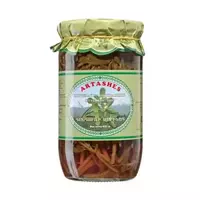Pickled pursuit

Interestingly, it was the French chefs who, like no one else, know a lot about culinary art who began to be the first to use purslane when preparing dishes. From France, this plant gradually began to spread throughout Europe and today is in quite wide demand.
Outwardly, the purslane is represented by a herbaceous plant, the stem of which creeps along the ground. The small leaves of the purslane are elongated, while the inflorescences of the plant can be of a completely diverse color and shade. However, not flowers, but greens and stems of purslane are so highly valued both by culinary experts and in representatives of alternative medicine.
Thus, the chemical composition of green-painted leaves and stems of the plant determines the healing and nutritional properties of the pursuit. The benefits of fresh purslane leaves are obvious, which consists in a high content of carotene, nicotinic and ascorbic acid along with tocopherol and phylloquinone.
Even ancient medicine doctors recognized the ability of the purslane to perfectly cleanse the body of various harmful compounds. And today this judgment is scientifically confirmed: pursuit is characterized by a diuretic effect, as well as the actions of a natural antioxidant. Often this plant is used as part of medicines and infusions that heal from insomnia, kidney and liver diseases, flatulence and colpitis.
Nevertheless, the pursuit finds wide application not only in medicine, but also in cooking. There are 3 main species of this plant - green, golden yellow and broad-leaved pursuit. It is customary to eat fresh sprigs of purslane, which are mainly added to mixes of fresh green lettuce leaves and other vegetable salads. Pickled pursuit is also harvested, which can subsequently be added to snacks, soups or second courses.
Pickled pursuit can also become a wonderful side dish for meat and fish dishes. True connoisseurs of pickled pursuit claim that this product has an excellent taste that resembles capers in some way, so it can often be used as a replacement for them.
In domestic grocery stores, if desired, you can find pickled pursuit on a shelf with canned vegetables. This product is completely ready for consumption, so all you need is to open the can and enjoy its taste. However, most culinary experts prefer to harvest it on their own, and this is quite easy to do.
First of all, for the preparation of homemade pickled pursuit, it is recommended to take young plants that are laid in jars either whole or cut in pieces. Often, the greens are previously blanched and then poured with marinade, which is made on the basis of water, vinegar, sugar, salt and various spicy additives.
pickled pursuit 18 kCal
The energy value of pickled pursuit (Ratio of proteins, fats, carbohydrates - ju):
Proteins: 1.49 g (~ 6 kCal)
Fats: 0.19 g (~ 2 kCal)
Carbohydrates: 3.55g (~ 14kCal)
Energy ratio (b | y): 33% | 10% | 79%
 Español
Español Français
Français Português
Português Русский
Русский 简体中文
简体中文 繁體中文
繁體中文 日本語
日本語 한국어
한국어 العربية
العربية Türkçe
Türkçe Қазақ
Қазақ Deutsch
Deutsch Italiano
Italiano Українська
Українська
